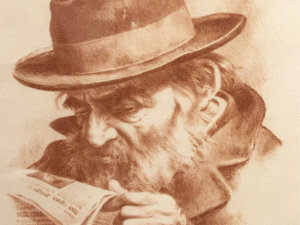Walking the Walk
Have you ever had the experience of recognizing someone in the distance simply by the way they walk? I have, many times. The height and build of the individual in question can be additional clues to their identity. But there’s nothing quite as distinctive as a person’s walk.
If you stop and think about it, this makes a certain amount of sense. The way a person uses his or her body is a reflection of his or her psyche. The outer movements mirror the inner reality.
For example, suppose you know a person who’s general approach to life is driven and purposeful. You’d expect his walk to look that way as well. Seeing such a Type A personality ooze languidly down the street would be nothing short of jarring. A contradiction. That kind of walk would seem to belong to the kind of individual who ambles or drifts through life, a person largely devoid of clear aims and burning ambitions.
An impatient person will tend to walk quickly; a chilled one has a gait that’s far more relaxed. A graceful walk reveals a certain inner equilibrium, while a jerky one might hint at impulsiveness. Those who are plagued by self-consciousness will walk… self-consciously. Their posture will be slightly stiff rather than natural, their step less than fluid. The sad or insecure individual might walk with shoulders slumped and a posture that’s not fully upright. And so on through all the twists and turns of personality.
There are other mirrors, too. If someone bites their nails, chews their lips, tugs at their hair or clothes or twists a curl obsessively around and around their finger, you may be able to accurately assess their inner world as a tense or nervous one. Inner calm, however, will reveal itself in slow, gracious movements.
These are not thought-out gestures. Nobody deliberately and with conscious forethought engages in nervous twitches or mannerisms. Like the way we walk, these things are the natural expression of what lies within.
The Writing on the Wall
Sefer Daniel tells the story of the mysterious writing that appeared on the wall of King Balshazar’s palace and was later interpreted by Daniel. Interestingly, many centuries later there are those who are still engaged in interpreting writing. Not miraculous words of Divine origin, but ordinary words written by ordinary people like you and me.
There’s a whole school of thought that believes that the way we write reflects who we are. Graphology, or handwriting analysis, studies the way a person forms his letters, the pressure with which he puts pen to paper, the spacing of the word on the page, and a host of other factors which, together, paint a picture of a personality. Handwriting, they claim, is a peephole into a person’s character.
Their thinking lies along much the same lines as our previous analysis of walking. The drives, impulses and traits that animate us from within must surely find outward expression: in the way we walk, in our gestures and speech, and in the way we write. True, we are all taught proper handwriting as a child. But our styles do not remain uniform. Over time, an individual picks up his own unique way of writing. For example, he learns to form certain letters more efficiently than he was taught, either by paring them down into simpler, more abstract shapes, or by creatively linking two letters together to save time and space.
And speaking of space, when it comes to writing we all have a different relationship to it. Some of us fill the page from margin to margin, while others feel free to squander it by leaving a great deal of white space between words and lines. This, the graphologists tell us, may correlate with how generous or tight-fisted we are with money. Alternatively, it can reveal just how close we like other people to get to us. Some of us need our “space” more than others!
A cramped, rigid writing belongs to a very different kind of person than one who writes with a loose, flowing script. How hard we press the pen down on the page can show not only how much physical energy we have, but also how much inner tension.
In short, there’s so much to be learned from all the ways a person expresses himself externally. They are all windows into the soul.
Reversing the Trend
With so many diverse kinds of therapies enjoying popularity these days, a system of “handwriting therapy” has evolved as well. This means working from the outside in: using your handwriting to help change a trait. Let me give you an example.
Suppose you learn that backward-leaning writing indicates a certain fearfulness. A fear of moving forward, a clinging to the past. Now, suppose you want to change this. You want to let go of the trammels of the past and feel brave enough to plunge confidently into whatever the future may hold. Handwriting therapy might suggest that you consciously reverse the trend of your writing, slanting your words to the right, which symbolizes the future, instead of back toward the left-hand margin which symbolizes the security of the past.
The letters of the alphabet are formed in three zones, the upper one representing the intellectual/spiritual area, the middle being the social zone, and the lower zone indicative of the practical and the physical aspects of life. A person who feels that she’s too cerebral and not grounded enough might be told to exert firmer pressure on the page, and to develop her lower zone to balance her highly developed upper zone.
Does this kind of therapy work? I don’t have the answer to that. But consider this: if a timid person holds his head high and walks with a firm, confident-looking tread, does that change the way he feels inside?
Common thought has it that it does. Like the lyrics of a charming old song:
While shivering in my shoes, I strike a careless pose
And whistle a happy tune, and no one ever knows I’m afraid.
The result of this deception is very strange to tell
For when I fool the people, I fear I fool myself as well!
It’s not really about fooling people. It’s about effecting change on the inside through making outward changes. Standing and walking differently makes us feel different. And so, perhaps, does writing differently. Who knows?
What I do know is that our Sages have firmly endorsed the view that outward actions impact inner attitudes. If we perform a mitzvah with a great deal of external zeal and reverence, chances are we’ll begin to feel more connected to it on the inside. If we are friendly to someone who usually leaves us cold, the very act of warming up our manner can light a fire in our heart.
It’s a strange phenomenon. If the yetzer hara is stalking you, we are taught, drag him to the bais medrash! Can it be that the mere act of opening a Gemara and immersing oneself in learning Torah is enough to convince us to abandon our less noble impulses?
It seems that it is.
So let’s take heart. Not all of our battles need to be fought with mighty clashes of armor on the bumpy terrain of our inner battlefields. There’s a more indirect, somewhat artificial, but highly effective way of gradually changing our problematic traits and middos.
And that’s by changing the way we do things on the outside.







